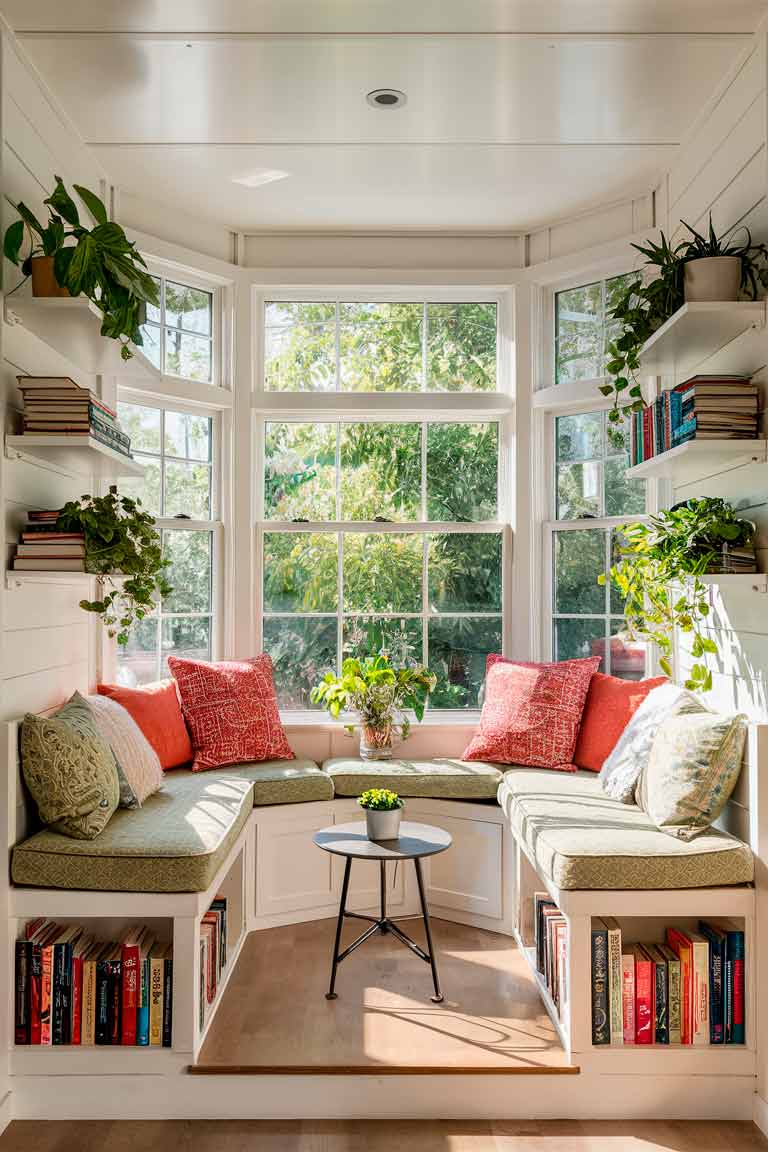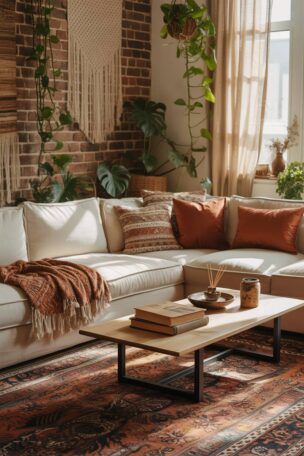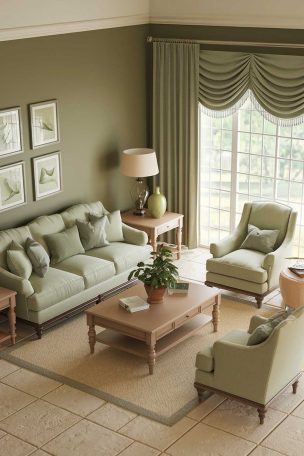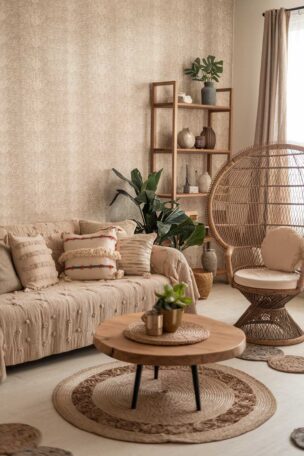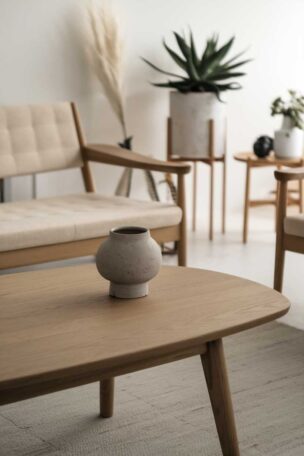The tiny house movement has taken the world by storm, challenging us to rethink our living spaces and embrace a more minimalist lifestyle. At the heart of any tiny home is the living room—a space that needs to be both functional and stylish.
Let’s explore some inspiring ideas to transform your compact living area into a cozy haven that reflects your personality and meets your needs.
Design Styles for Tiny House Living Rooms
When it comes to tiny house living rooms, the key is choosing a design style that looks great and maximizes your limited space. Let’s explore some popular options that can turn your tiny living room into a stylish retreat.
Modern Minimalism
Modern minimalism is a perfect fit for tiny house living rooms. It emphasizes clean lines, uncluttered spaces, and a “less is more” philosophy that’s ideal for small areas.
Scandinavian-Inspired Designs
Scandinavian design, with its focus on simplicity and functionality, is a natural choice for tiny living rooms.
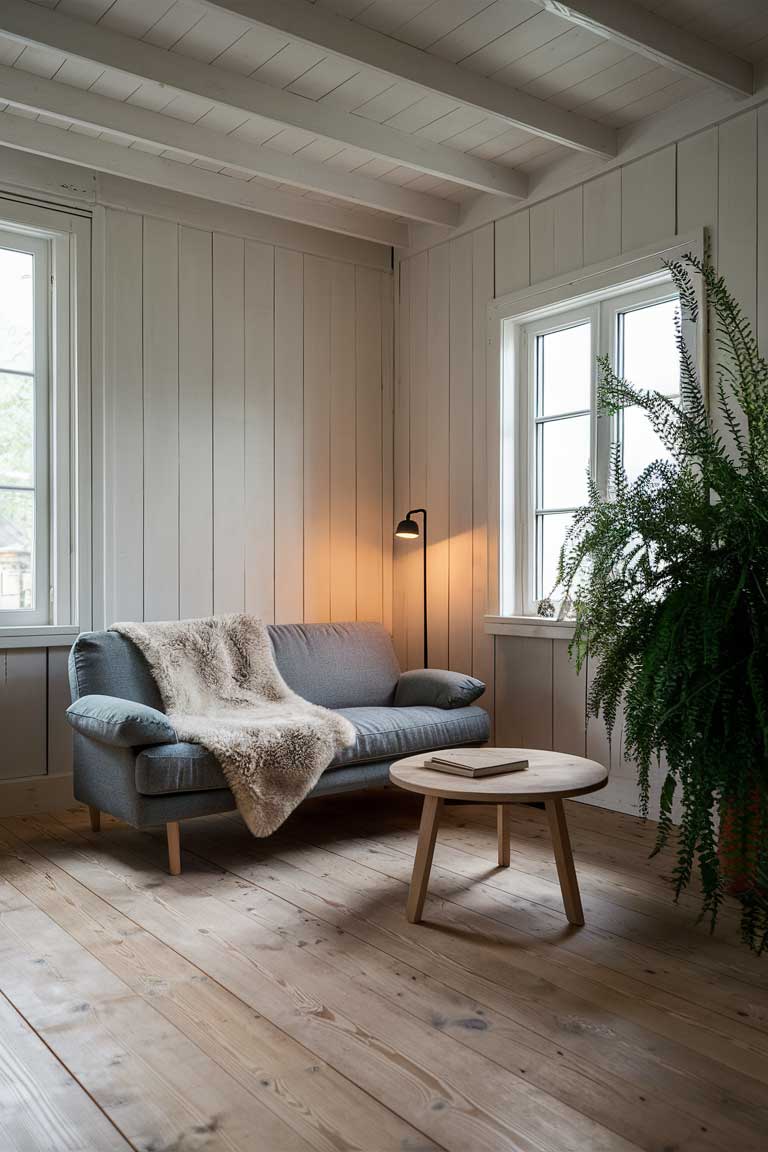
This design style typically features:
- Light wood floors and white walls to create an illusion of space
- Compact gray sofas with cozy sheepskin throws for comfort
- Round, natural wood coffee tables that don’t overwhelm the space
- Slim floor lamps for space-saving lighting
The key to nailing this look is to keep things simple and uncluttered. Choose furniture with clean lines and avoid excessive decorations. A single, large potted plant can add just the right amount of natural elements to the space.
Industrial Chic Elements
For those who prefer a more urban vibe, industrial chic can be a great option for tiny house living rooms.
![18 Tiny House Living Room Ideas to Transform Your Home 2 A tiny house living room with exposed brick walls. A compact dark leather sofa sits against one wall. In front of it is a reclaimed wood coffee table with metal legs. A small, black metal shelving unit holds books and decorative items. An industrial-style pendant light hangs from the ceiling, casting a warm glow over the room.]](https://simplespaces.net/wp-content/uploads/an-intimate-and-cozy-living-room-in-a-tiny-house.jpg)
This style often incorporates:
- Exposed brick walls for texture and character
- Dark leather sofas that are both durable and stylish
- Reclaimed wood coffee tables with metal legs, combining rustic and industrial elements
- Black metal shelving units for storage and display
The industrial chic style allows you to play with textures and materials. The combination of wood, metal, and leather creates a rich, layered look that can make your tiny living room feel both cozy and sophisticated.
Cozy and Eclectic
If you love a more relaxed, lived-in feel, cozy and eclectic styles might be right up your alley. These designs allow for more personal expression and can make your tiny living room feel like a true reflection of your personality.
Bohemian Retreat
Bohemian style, with its mix of patterns, textures, and colors, can create a warm and inviting atmosphere in a tiny living room.
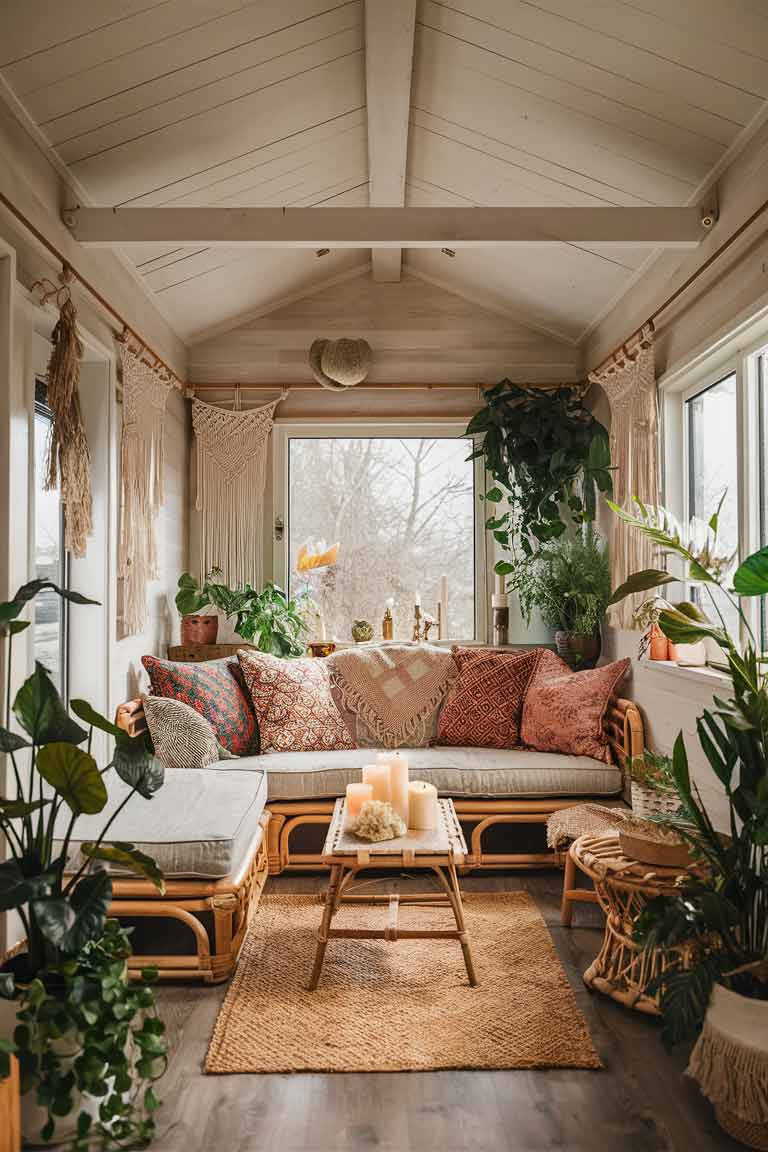
Key elements of a bohemian tiny living room include:
- Low-profile rattan sofas with an array of colorful, patterned cushions
- Macramé wall hangings for added texture and visual interest
- Small wooden coffee tables adorned with candles for a warm ambiance
- A variety of indoor plants to bring nature indoors
The beauty of bohemian style is its “anything goes” approach. Mix and match patterns, layer textures, and don’t be afraid to incorporate bold colors. Just remember to keep the overall layout uncluttered to avoid overwhelming the small space.
Farmhouse Cozy
The farmhouse style has gained immense popularity in recent years, and it can work wonderfully in a tiny house living room, creating a cozy, welcoming atmosphere.
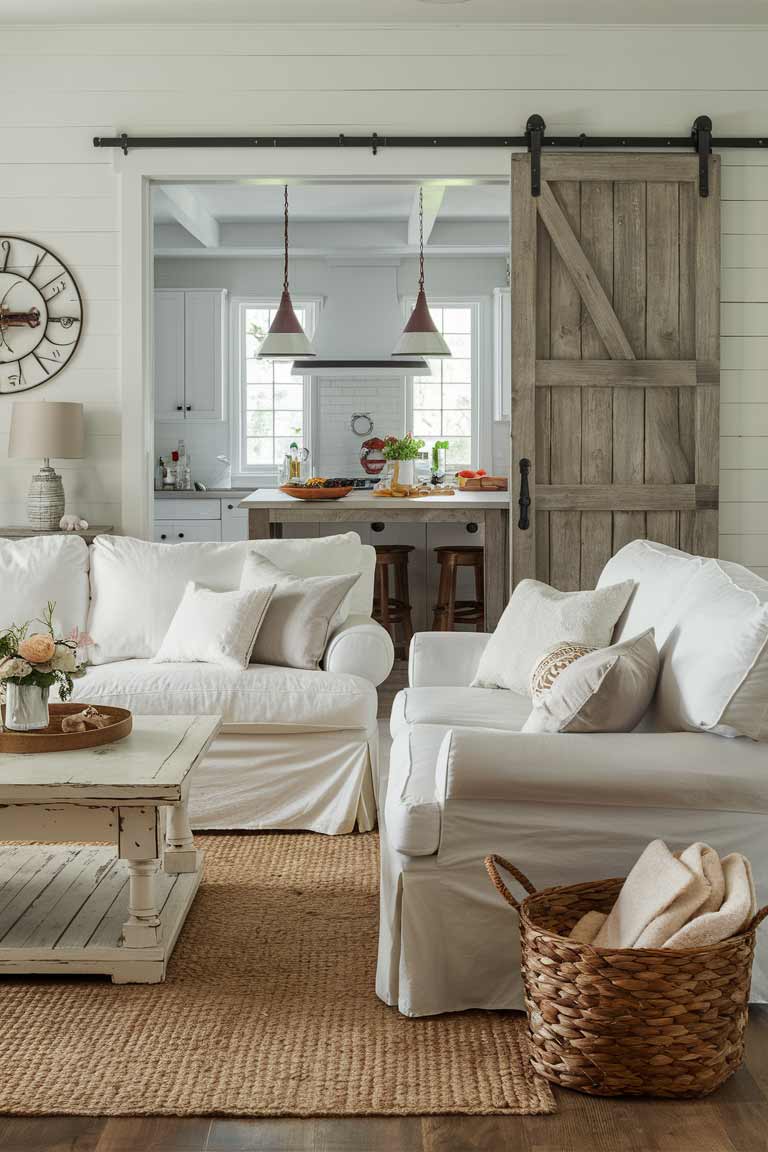
Farmhouse style in a tiny living room often features:
- White slipcovered sofas with an assortment of throw pillows
- Distressed wooden coffee tables for that rustic charm
- Woven baskets for practical and stylish storage of blankets and throws
- Sliding barn doors to separate living areas while saving space
The key to farmhouse style is mixing comfort with rustic elements. Use a neutral color palette as your base and add warmth through textures and natural materials. Don’t forget to incorporate some vintage or antique pieces for that authentic farmhouse feel.
Vintage and Glamorous
Who says tiny living rooms can’t be glamorous? You can create a compact and luxurious space with the right design choices.
Mid-century Modern Flair
Mid-century modern design, with its clean lines and organic forms, can be an excellent choice for tiny living rooms.
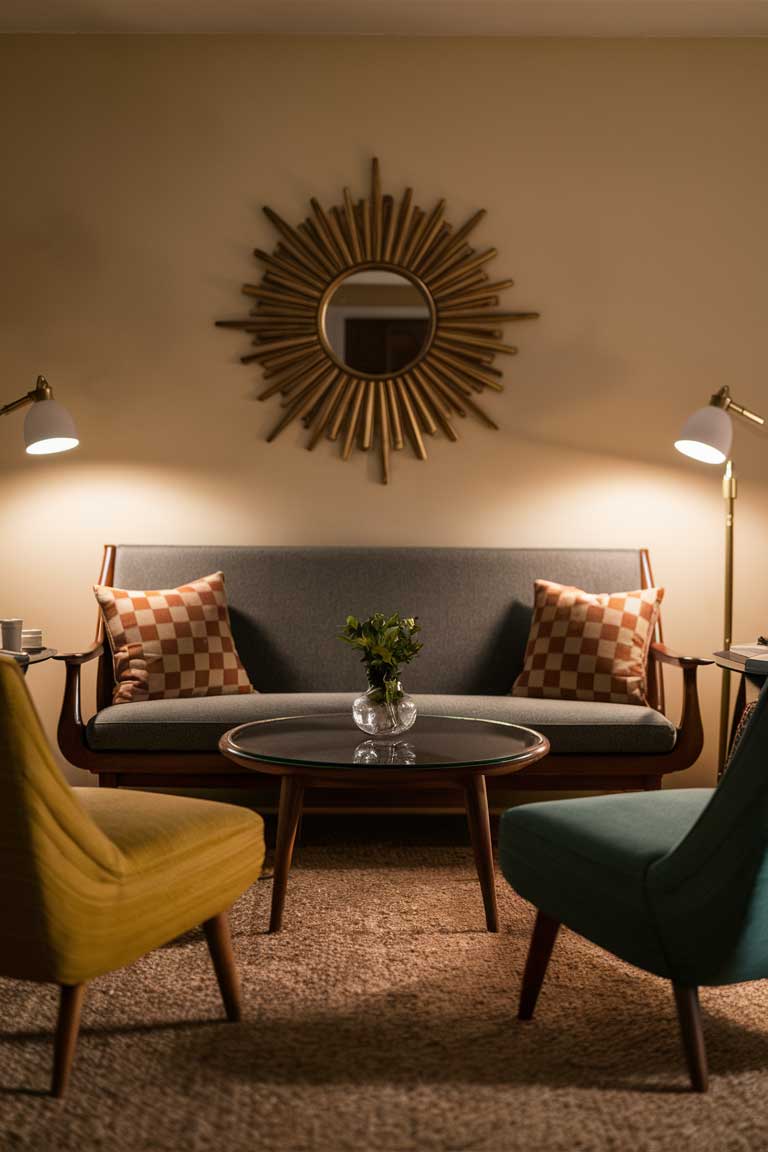
Key elements of a mid-century modern tiny living room include:
- Sleek, low-profile wooden sofas with tapered legs
- Geometric-patterned cushions for visual interest
- Round coffee tables with glass tops to maintain an open feel
- Vintage armchairs and iconic pieces like sunburst mirrors
The beauty of mid-century modern design lies in its simplicity and functionality, making it perfect for small spaces. Choose furniture with slim profiles and elevated legs to create a sense of openness. Don’t forget to add some iconic mid-century patterns or artwork to complete the look.
Vintage Glam
For those who love a touch of luxury, a vintage glam style can turn a tiny living room into a sophisticated space.
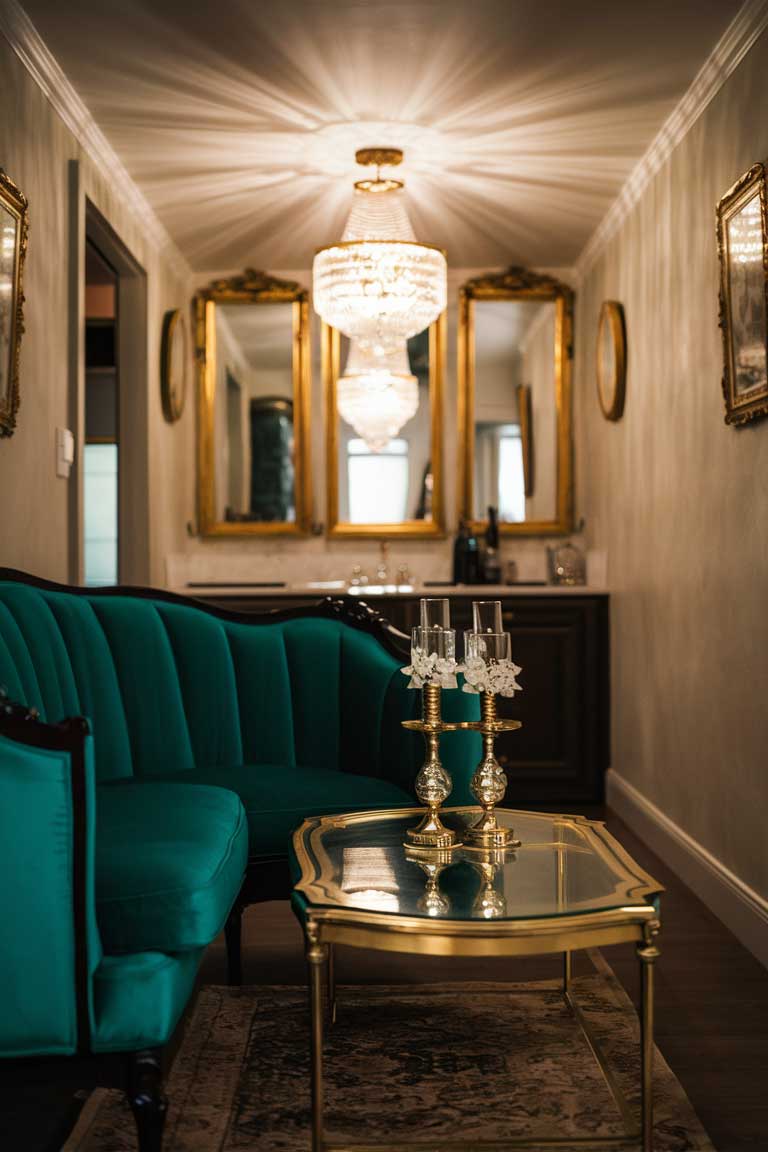
Vintage glam in a tiny living room often incorporates:
- Velvet loveseats in rich, jewel tones like emerald or sapphire
- Glass coffee tables with gold or brass accents
- Chandeliers for a touch of luxury and ambient lighting
- Ornate mirrors and framed vintage prints on the walls
The key to vintage glam in a small space is to choose a few standout pieces rather than overcrowding the room. A luxurious velvet sofa or a stunning chandelier can become the focal point, while smaller accents like gold-framed mirrors can add sparkle without taking up too much space.
Space-Saving Solutions
In a tiny house, every inch counts. That’s why it’s crucial to incorporate clever space-saving solutions that allow your living room to serve multiple functions without feeling cramped.
Multi-Functional Furniture
The secret to a well-designed tiny living room often lies in choosing furniture that can serve multiple purposes.

Some great multi-functional furniture ideas include:
- Sofas with built-in storage compartments underneath
- Coffee tables that double as storage chests
- Daybeds that provide seating during the day and sleeping space at night
- Murphy beds that can be tucked away when not in use
- Fold-out tables that can serve as dining or work areas
These pieces of furniture allow you to maximize your living space without sacrificing style or comfort. For instance, a sofa with built-in storage can help you keep blankets, books, or other items out of sight, maintaining a clutter-free look. A lift-top coffee table can transform into a work surface or dining table when needed, then return to its original form when you’re done.
Clever Storage Ideas
In addition to multi-functional furniture, incorporating smart storage solutions can help keep your tiny living room organized and spacious.
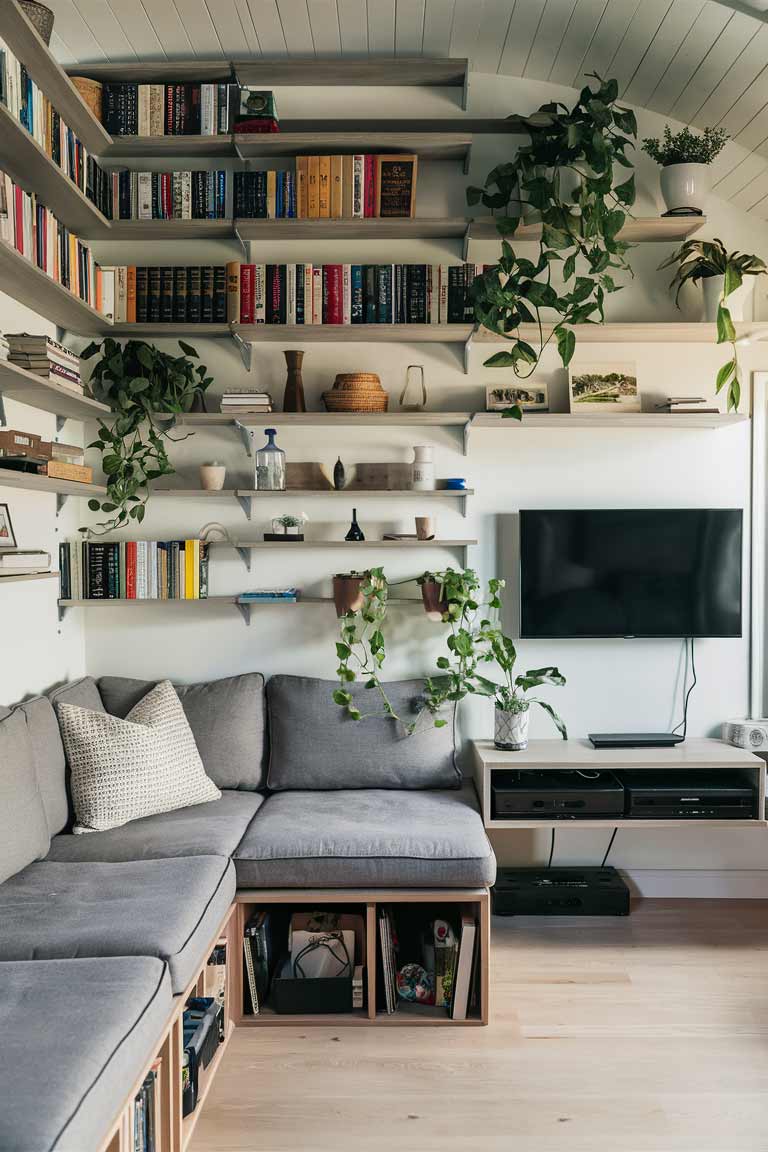
Some effective storage ideas for tiny living rooms include:
- Floating shelves to maximize vertical space
- Built-in storage solutions along walls
- Under-sofa storage compartments
- Corner sofas to optimize floor space
- Wall-mounted TVs to free up floor area
The key is to think vertically and use every available nook and cranny. Floating shelves, for example, provide storage and display space without taking up valuable floor real estate. A corner sofa not only maximizes seating but can also include hidden storage beneath the cushions. By mounting your TV on the wall, you eliminate the need for a bulky entertainment center, creating more open space in your living room.
Remember, the goal is to keep your tiny living room open and uncluttered while still having all the necessary functionality. With these clever storage solutions, you can achieve a practical and visually appealing space.
Maximizing Natural Light and Openness
In a tiny house living room, creating a sense of spaciousness is crucial. One of the most effective ways to achieve this is by maximizing natural light and emphasizing openness in your design.
Window Treatments
The right window treatments can greatly affect how open and airy your tiny living room feels.
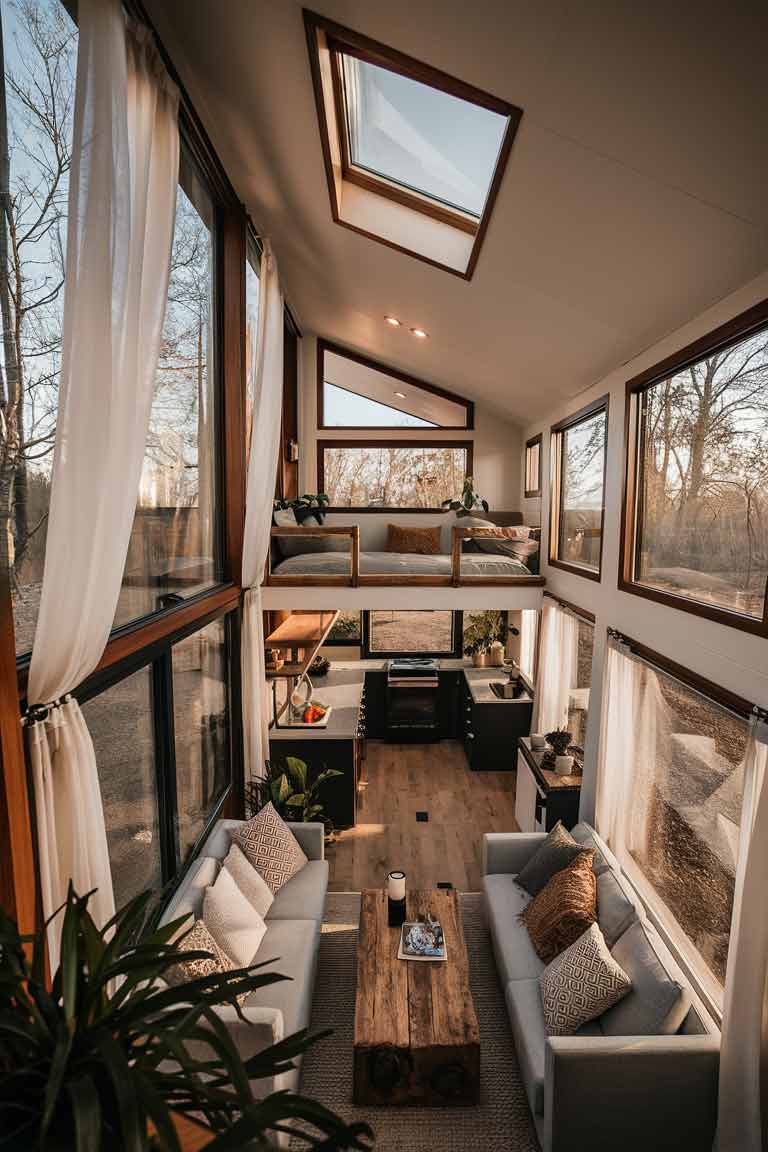
Consider these window treatment ideas:
- Large windows with sheer curtains to let in maximum light while maintaining privacy
- Floor-to-ceiling windows to create an illusion of more space and connect the interior with the outdoors
- Skylights bring in overhead natural light, especially useful in rooms with limited wall space for windows
Sheer curtains are an excellent choice for tiny living rooms as they allow light to filter through even when closed, maintaining a bright, open feel. If privacy is a concern, consider layering sheer curtains with heavier drapes that can be pulled closed when needed.
Floor-to-ceiling windows can dramatically open up a small space, making the room feel larger than it is. They also provide a great view of the outdoors, which can make your living room feel more expansive.
Skylights are a fantastic option if your tiny house design allows for them. They bring in natural light from above, which can be especially beneficial in rooms with limited wall space for windows.
Open Floor Plans
An open floor plan can make your tiny house feel much more spacious by eliminating unnecessary walls and allowing for a more flexible use of space.
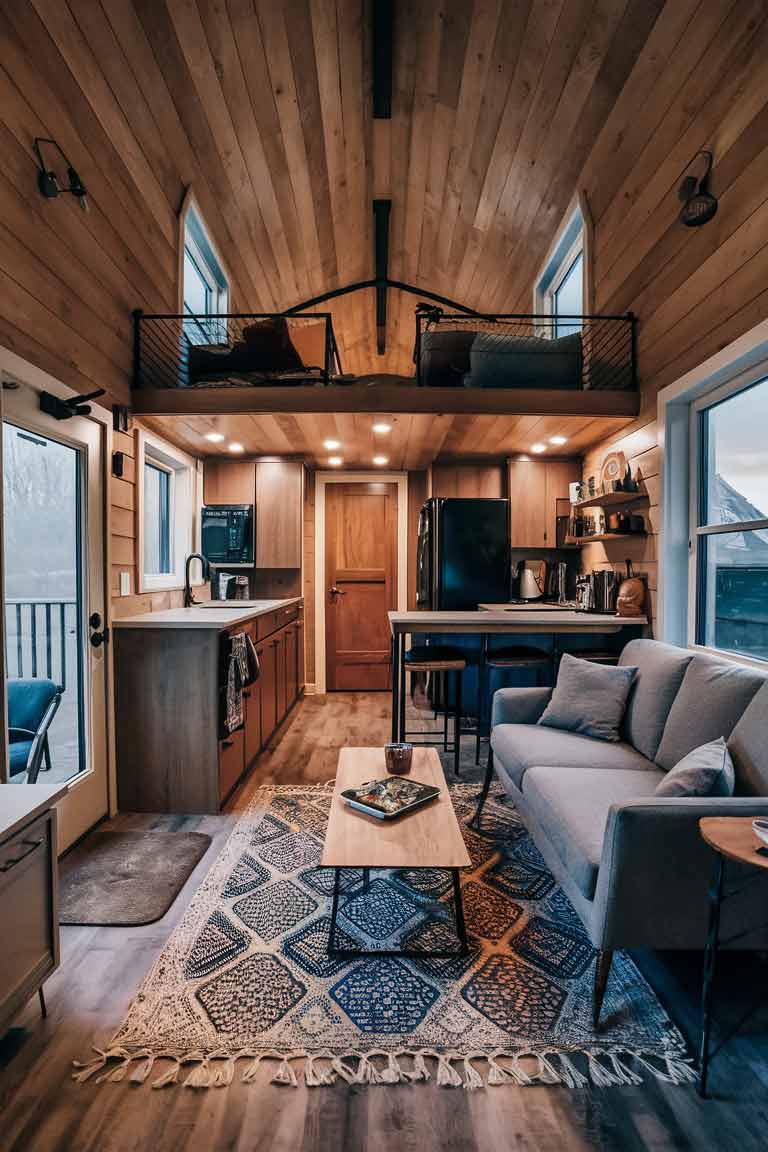
Key elements of an open floor plan in a tiny house:
- Seamless blending of living room and kitchen areas
- Use of rugs to define different functional spaces
- Consistent decor themes for visual flow
In an open floor plan, you can use furniture placement and area rugs to define different functional zones without the need for walls. For example, a rug under your living room furniture can visually separate it from the kitchen area.
Maintaining a consistent decor theme throughout the open space helps create a cohesive look. This doesn’t mean everything has to match exactly, but using a consistent color palette and complementary styles can tie the different areas together.
Remember, an open floor plan aims to create a sense of flow and spaciousness. Avoid cluttering the space with too much furniture or decor. Instead, choose pieces that serve multiple functions and maintain clear pathways between different areas of your tiny house.
By maximizing natural light and embracing an open floor plan, you can create a tiny house living room that feels spacious, bright, and inviting.
Color and Texture in Tiny Living Rooms
Color and texture are crucial in any interior design, but they’re especially important in tiny living rooms. The right choices can make your space feel larger, more cohesive, and full of personality.
Color Schemes
Choosing the right color scheme can dramatically affect your tiny living room’s spaciousness.
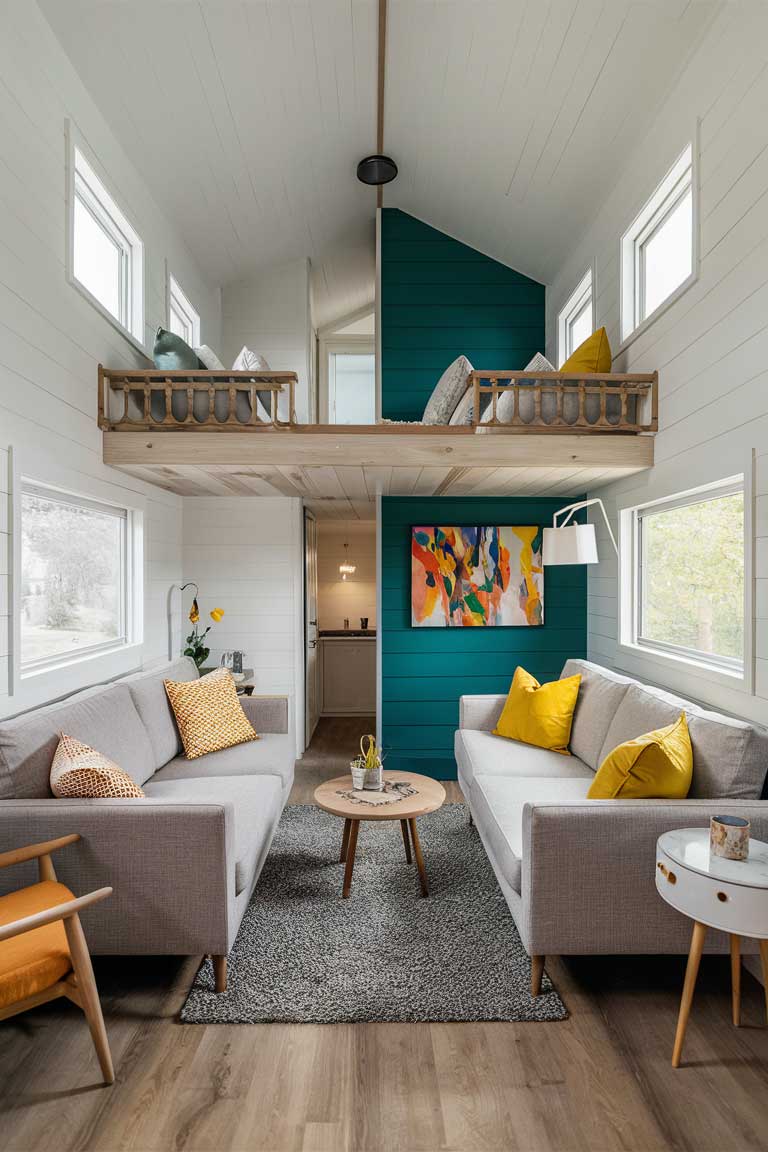
Consider these color strategies for your tiny living room:
- Neutral palettes for a sense of spaciousness:
- Light colors like white, beige, and soft gray can make a room feel more open and airy
- Use varying shades of the same color to add depth without overwhelming the space
- Bold accent walls for personality:
- A single wall in a bold color can add character without making the room feel smaller
- Choose deep, rich colors like navy, forest green, or burgundy for a sophisticated look
- Pops of color through accessories and cushions:
- Add vibrant colors through easily changeable items like throw pillows, artwork, or small decor pieces
- This allows you to update your color scheme seasonally or as your tastes change
Remember, while light colors generally make a space feel larger, don’t be afraid to incorporate darker hues or bold colors if that’s your style. The key is to use them strategically and balance them with lighter elements.
Textures and Materials
Incorporating a variety of textures can add depth and interest to your tiny living room, making it feel more dynamic and inviting.
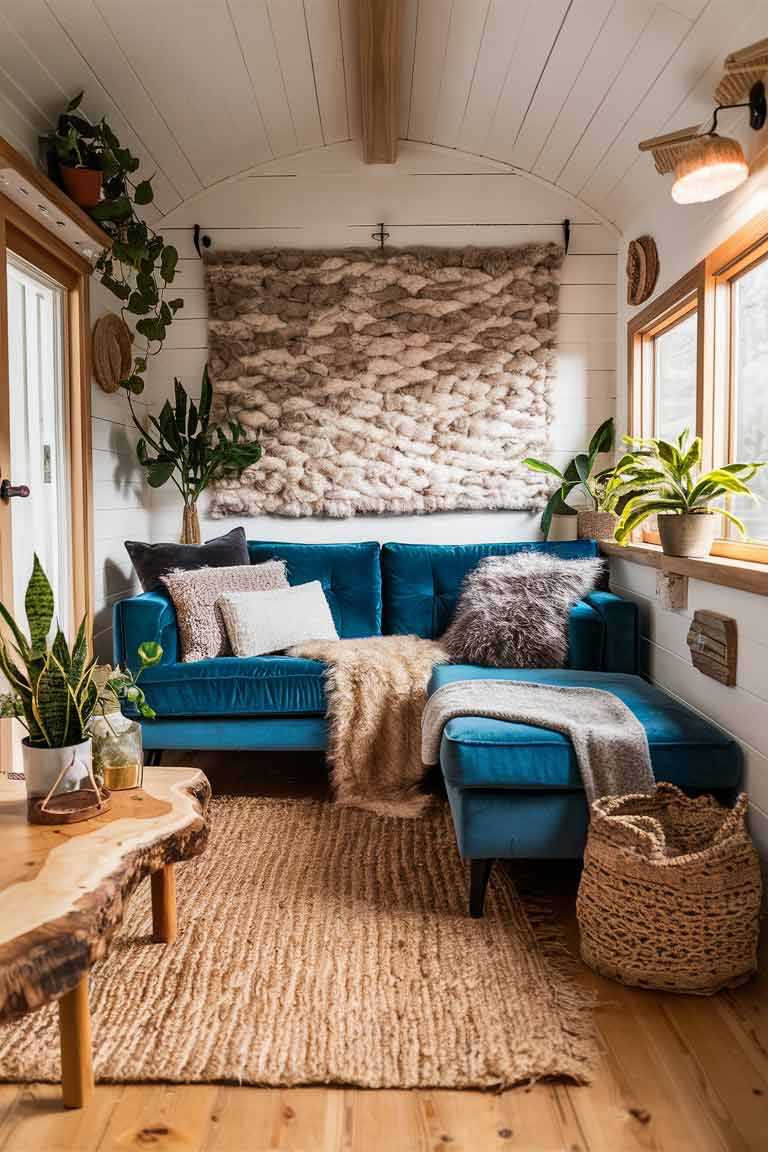
Consider incorporating these textures and materials:
- Mix of fabrics:
- Velvet for a touch of luxury
- Wool for warmth and coziness
- Jute or sisal for a natural, organic feel
- Faux fur or sheepskin for softness and comfort
- Natural elements:
- Wood furniture or accents for warmth
- Stone or concrete elements for an industrial touch
- Plants to bring life and texture to the space
- Textured rugs to anchor the space:
- A plush area rug can add comfort underfoot
- A textured rug can define the living area in an open floor plan
When incorporating different textures, aim for balance. Too many rough textures can make a space feel uncomfortable, while too many smooth surfaces might feel cold or sterile. Mix and match to create a space that’s visually interesting and inviting to touch.
Also, consider the scale of textures in relation to your small space. Large-scale textures, like a chunky knit throw or a big-weave rug, can sometimes overwhelm a tiny room. Opt for smaller-scale textures or use large textures sparingly as statement pieces.
By thoughtfully combining colors and textures, you can create a tiny living room that feels rich, layered, and full of personality despite its small size.
Specialized Tiny House Living Room Concepts
Sometimes, a specific theme or concept can tie your tiny living room together, creating a cohesive and inspiring space. Let’s explore some specialized concepts that can work beautifully in tiny house living rooms.
Nature-Inspired Retreats
Bringing elements of nature into your tiny living room can create a calming, rejuvenating space that feels connected to the outdoors.
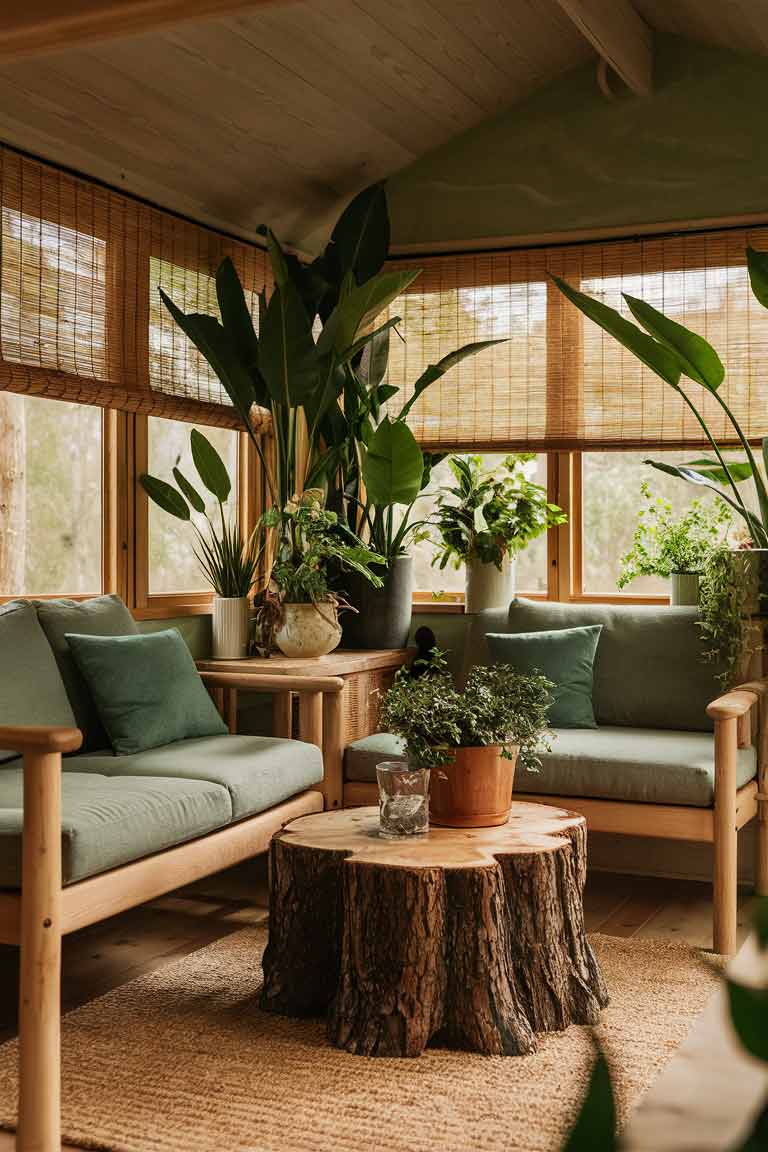
Key elements of a nature-inspired tiny living room include:
- Wooden furniture with green cushions for a forest-like feel
- Tree stump coffee tables or side tables for a rustic touch
- Large potted plants to bring the outdoors inside
- Earthy wall colors like soft greens or warm browns
- Natural fiber textiles like cotton, linen, or hemp
The key to nailing this look is to incorporate natural materials and colors throughout the space. Use a variety of plants – from large floor plants to small succulents – to create a lush, green environment. Choose furniture with organic shapes and natural finishes to enhance the nature-inspired theme.
Remember, even in a tiny space, you can create a sense of bringing the outdoors in. Use large windows or glass doors to blur the lines between inside and outside if possible. If your tiny house is in a natural setting, position your living room to take advantage of any scenic views.
Urban Loft Style
An urban loft style can work wonderfully in a tiny living room for those who prefer a more modern, city-inspired look.
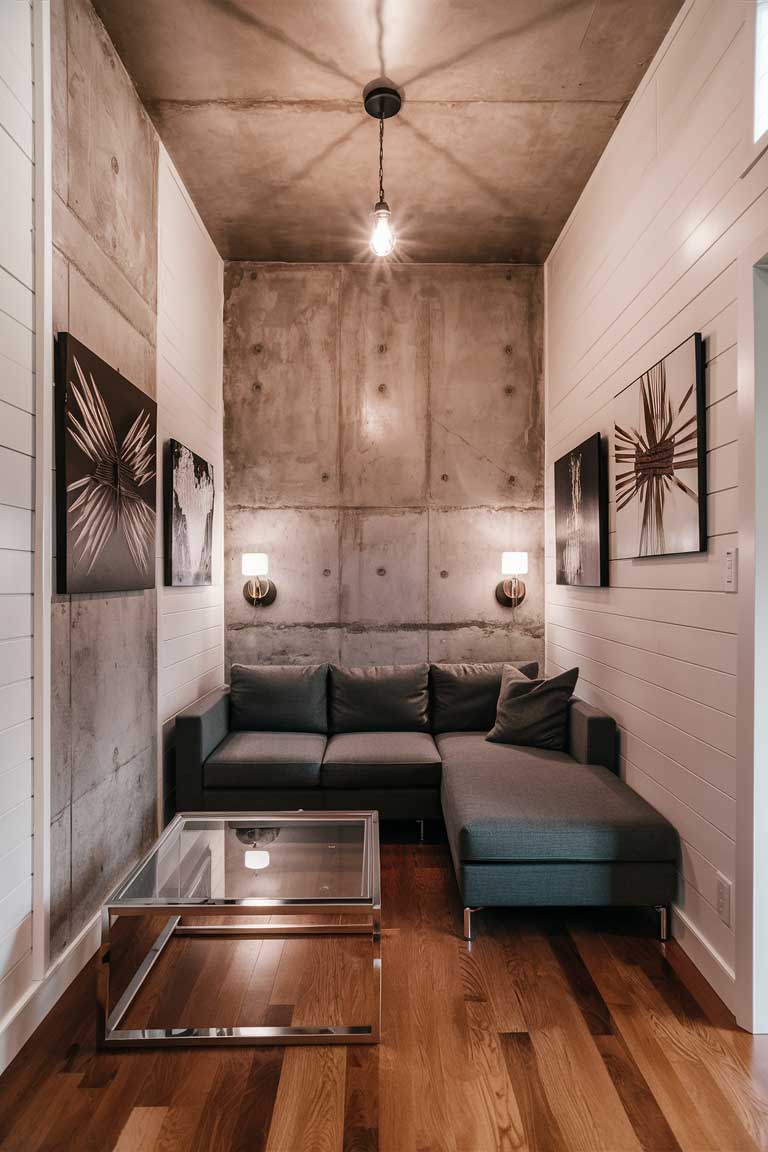
Elements of an urban loft style tiny living room include:
- Exposed concrete walls or faux concrete finishes for an industrial touch
- Metal and glass furniture to maintain an open feel
- Modern art pieces to add personality and color
- Edison bulb lighting or other industrial-style fixtures
The urban loft style is all about embracing a raw, industrial aesthetic while maintaining a sense of sophistication. In a tiny living room, this can be achieved by keeping the color palette neutral – think grays, whites, and blacks – and letting textures and materials take center stage.
Use furniture with slim profiles to maintain an open feel. A compact sectional sofa in a neutral color can provide ample seating without overwhelming the space. Pair it with a metal and glass coffee table to reinforce the industrial vibe while keeping the visual space open.
Remember lighting—it plays a crucial role in urban loft style. Exposed bulb fixtures, like Edison bulbs, can add warmth and character to your tiny living room while staying true to the industrial aesthetic.
Coastal Living
A coastal-inspired tiny living room can create a light, airy space that feels like a permanent vacation.
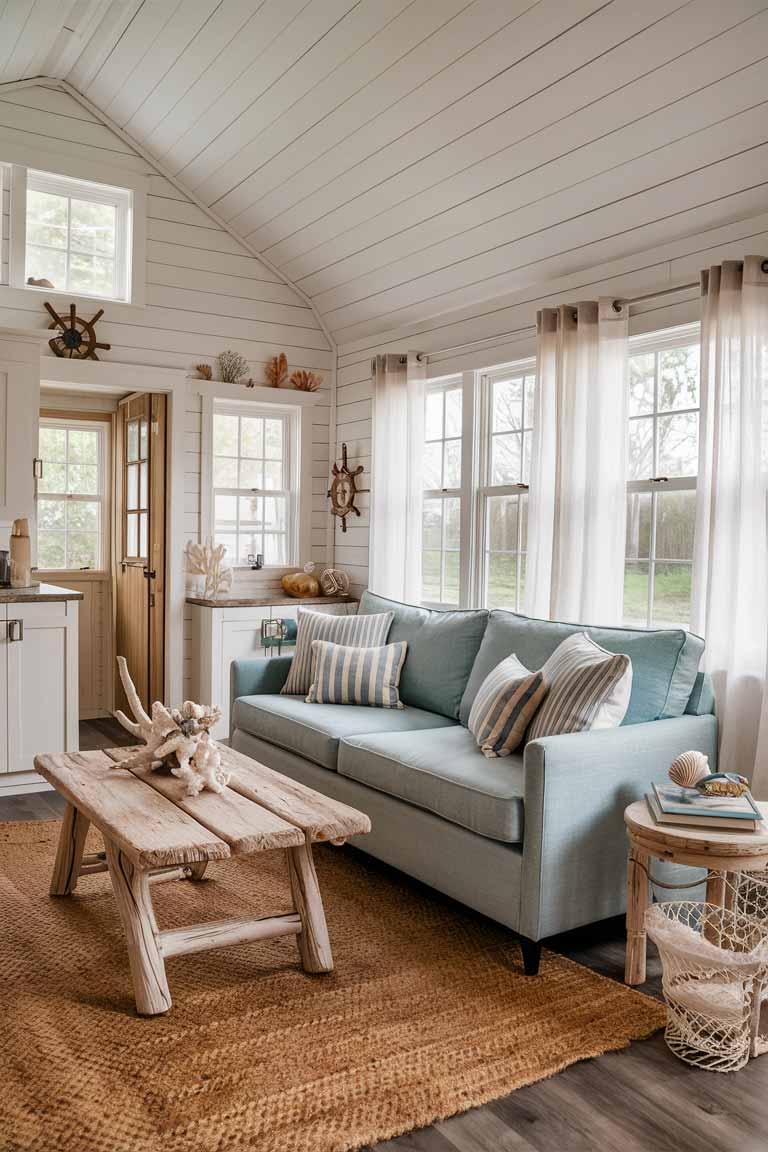
Key features of a coastal tiny living room include:
- White shiplap walls for a classic beach house look
- Light blue sofas or chairs with striped cushions
- Driftwood coffee tables or side tables
- Large windows with sheer curtains to maximize natural light
- Jute rugs for added texture and a beachy feel
The coastal style is all about creating a light, breezy atmosphere that evokes the feeling of being by the sea. In a tiny living room, this can be achieved through a combination of color, texture, and carefully chosen decor.
Start with a base of white or very light neutral colors for your walls and larger furniture pieces. Then, add in shades of blue – from light sky blue to deeper navy – to represent the ocean. Use natural textures like jute, rattan, or weathered wood to add depth and interest to the space.
Decor plays a big role in coastal style. Incorporate elements like seashells, coral, or nautical items like a ship’s wheel or anchor. But remember, in a tiny space, a little goes a long way – choose a few statement pieces rather than cluttering the space with too many small items.
By focusing on one of these specialized concepts – be it nature-inspired, urban loft, or coastal – you can create a tiny living room with a strong, cohesive theme that reflects your personal style and makes the most of your small space.
Personalization and Decor
While functionality is crucial in a tiny house living room, personal touches and decor are what truly make the space feel like home. Let’s explore some ways to add character and personality to your compact living area.
Gallery Walls
A gallery wall can be a fantastic way to express your personality and add visual interest to your tiny living room without taking up valuable floor space.
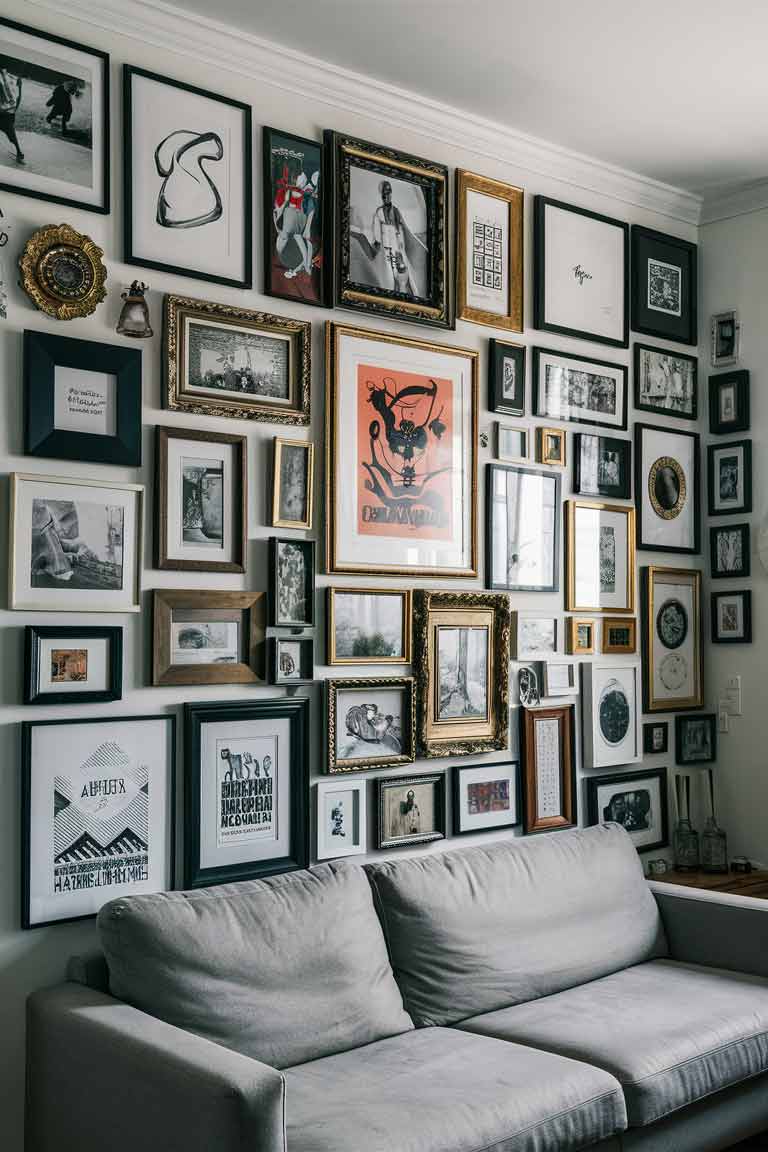
Key elements of a successful gallery wall in a tiny living room:
- Mix of art and personal photos for a curated, personal feel
- Eclectic frame styles and sizes to add visual interest
- A balanced arrangement that doesn’t overwhelm the space
When creating a gallery wall in a tiny living room, start by choosing a theme or color scheme to tie everything together. This could be as simple as using all black and white photos, or as complex as curating a collection of art and objects that tell your personal story.
Remember, in a small space, your gallery wall will be a major focal point. Don’t be afraid to let it make a big statement, but do keep the rest of your decor relatively simple to avoid visual clutter.
Reading Nooks
Even in a tiny living room, carving out a cozy reading nook can add functionality and charm to your space.
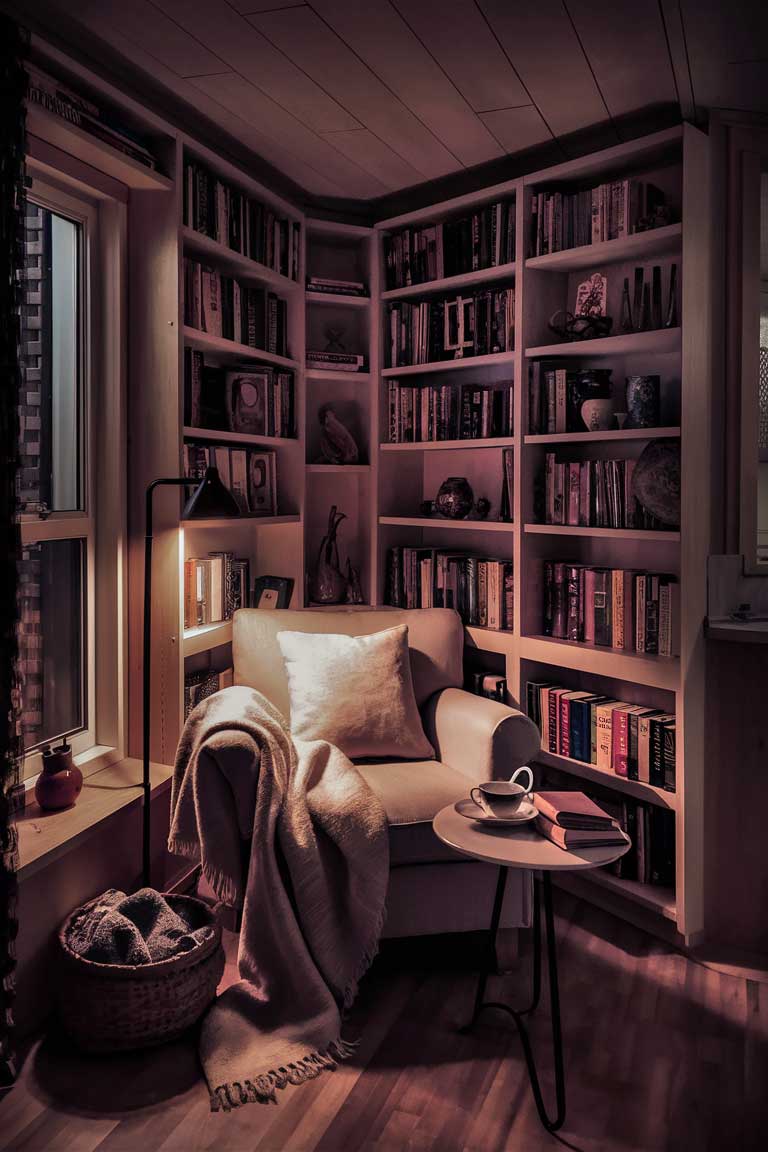
Essential elements of a tiny living room reading nook:
- Comfortable armchair or small loveseat
- Good lighting, preferably a floor lamp that can be adjusted
- Side table for books and drinks
- Built-in bookshelves or floating shelves for book storage
Creating a reading nook in your tiny living room is all about maximizing comfort in a small footprint. Choose a chair that’s comfortable but doesn’t overwhelm the space. If possible, opt for built-in bookshelves around your nook to maximize storage without taking up floor space.
Lighting is crucial for a good reading nook. A slim floor lamp can provide ample light without taking up much space. If possible, position your nook near a window to take advantage of natural light during the day.
Statement Pieces
In a tiny living room, a single statement piece can have a big impact, adding personality and style to your space.
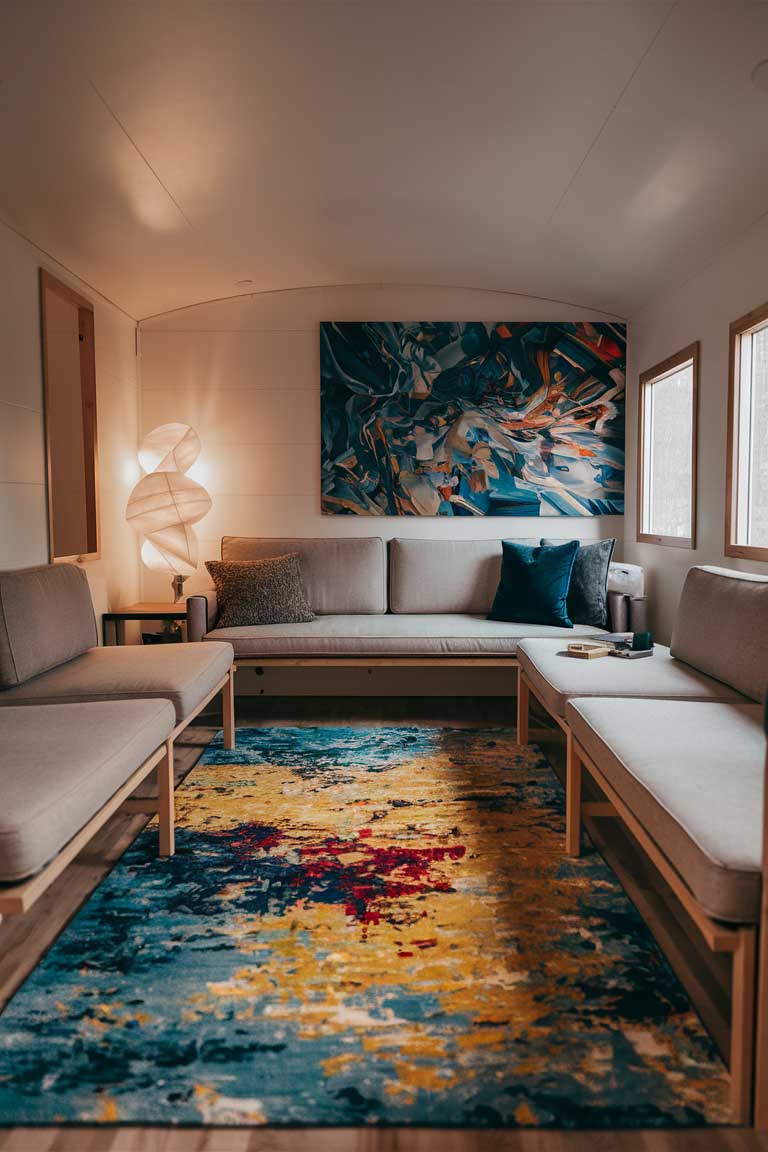
Ideas for statement pieces in a tiny living room:
- Bold, patterned rugs as focal points
- Unique lighting fixtures that double as art
- Eye-catching artwork or mirrors
Consider scale carefully when choosing a statement piece for your tiny living room. A large, colorful rug can define your living area and add personality without taking up any additional space. An oversized piece of art or a unique mirror can draw the eye up, making your ceiling feel higher and your room larger.
Lighting can also serve as a statement piece. Consider a sculptural floor lamp or a unique pendant light that doubles as a piece of art.
Remember, when you have a strong statement piece, it’s important to let it shine. Keep the rest of your decor relatively simple to avoid overwhelming the space.
By incorporating personal touches like a gallery wall, a cozy reading nook, or a striking statement piece, you can transform your tiny living room from a purely functional space into a true reflection of your personality and style. The key is to choose elements that speak to you while always keeping in mind the scale and functionality of your compact space.
Conclusion
Designing a tiny house living room is all about balancing style, functionality, and personal expression within a compact space. From embracing modern minimalism to creating cozy bohemian retreats, the possibilities are endless. The key is to choose a design style that resonates with you and then adapt it to work within your small footprint.
Remember these key points as you design your tiny living room:
- Multi-functional furniture and clever storage solutions are your best friends in maximizing space.
- Lighting and color choices can dramatically affect how spacious your room feels.
- Textures and materials add depth and interest to your space without taking up valuable square footage.
- Specialized concepts like nature-inspired, urban loft, or coastal themes can help create a cohesive look.
- Personal touches and statement pieces are what truly make your tiny living room feel like home.
Whether you’re living in a tiny house by choice or necessity, your living room can be a beautiful, functional space that perfectly suits your needs and style. Don’t be afraid to experiment, mix different elements, and make the space truly your own. After all, the beauty of a tiny house is that it challenges us to think creatively and focus on what really matters in our living spaces.
With these ideas and tips, you’re well-equipped to create a tiny living room that feels spacious, stylish, and uniquely yours. Remember, in tiny house living, every inch counts – but so does every ounce of personality you bring to the space. Happy decorating!

